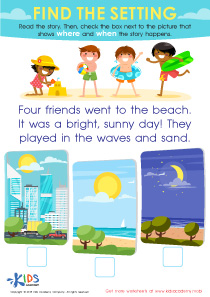Easy Matching worksheets activities for Ages 7-9
5 filtered results
-
From - To
Discover our enjoyable and educational Easy Matching Worksheets for Ages 7-9, designed to enhance critical thinking and cognitive skills through fun activities! These engaging worksheets feature a variety of themes, including animals, colors, and everyday objects, to capture children's interest while promoting learning through play. Perfect for home or classroom use, these activities help kids practice their matching skills, boost memory retention, and develop logical reasoning in a delightful manner. With colorful illustrations and kid-friendly designs, our worksheets make learning fun and interactive. Explore our collection to find the perfect matching activity for your child's age and skill level today!


Counting Birds Worksheet


Fruity Array Quest Worksheet


Colorful Arrays Bingo Worksheet


House Numbers Worksheet


What Time Is it? Hour Hands Worksheet
Easy Matching activities for children aged 7-9 are particularly valuable for parents and teachers as they foster essential cognitive and social skills pivotal for a child's development. At this age, children are honing their ability to think critically and solve problems, and matching activities help reinforce these skills through engaging and enjoyable tasks.
These activities enhance memory retention, as children are required to recall information and make associations, strengthening their cognitive abilities. Furthermore, Easy Matching tasks promote vocabulary development, numeracy, and pattern recognition, all of which are foundational for academic success. Through gameplay and teamwork, these activities also foster social skills, encouraging cooperation and communication among peers.
Additionally, matching activities can be easily integrated into various subjects, making learning interdisciplinary and less daunting. They offer a playful approach to education, allowing children to learn while having fun, thereby increasing their enthusiasm and motivation towards new concepts. Lastly, they can be differentiated to meet the needs of diverse learners, ensuring that all children can participate meaningfully. By prioritizing Easy Matching activities, parents and teachers can create a richer, more inclusive learning environment that prepares children for greater challenges ahead.
 Assign to My Students
Assign to My Students



.jpg)

.jpg)









